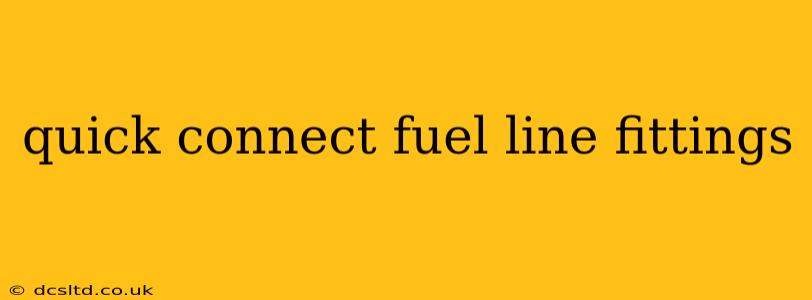Quick connect fuel line fittings are essential components in modern fuel systems, offering a convenient and reliable method for connecting and disconnecting fuel lines. Their ease of use and secure connection make them popular in various applications, from automobiles and motorcycles to agricultural machinery and marine engines. However, choosing the right fitting and understanding its proper use is crucial for safety and performance. This guide will delve into the world of quick connect fuel line fittings, addressing common questions and concerns.
What are Quick Connect Fuel Line Fittings?
Quick connect fuel line fittings, also known as push-to-connect or quick disconnect fuel line fittings, are designed for rapid connection and disconnection of fuel lines without the need for tools. They typically consist of a male and a female connector. The male connector features a locking mechanism that engages with the female connector when pushed together, creating a secure seal. Disconnection usually involves pressing a release tab or collar. These fittings are available in various sizes and materials, depending on the application and fuel type. Common materials include brass, steel, and various types of plastic, each offering different levels of durability and chemical resistance.
What are the Different Types of Quick Connect Fuel Line Fittings?
Several types of quick connect fuel line fittings exist, each designed for specific applications and pressure requirements. These can be categorized by:
- Material: As mentioned above, materials range from durable brass and steel for high-pressure applications to more cost-effective plastics for lower-pressure systems. The choice depends on the fuel's compatibility and the system's pressure rating.
- Size and Diameter: Fittings are available in a variety of sizes, measured in inches or millimeters, to accommodate different fuel line diameters. It is critical to match the fitting to the fuel line size for a proper seal.
- Locking Mechanism: The design of the locking mechanism varies; some use a simple push-and-release system, while others may incorporate a more complex locking system for increased security, particularly in high-pressure applications.
- Type of Connector: There are straight connectors, 90-degree connectors, and various other configurations to accommodate different routing needs in fuel systems.
How Do I Choose the Right Quick Connect Fuel Line Fitting?
Selecting the appropriate quick connect fuel line fitting involves several considerations:
- Fuel Type: The material of the fitting must be compatible with the fuel being used. Some materials may be susceptible to degradation or corrosion by certain fuels.
- Pressure Rating: The fitting's pressure rating must be equal to or exceed the maximum pressure within the fuel system.
- Flow Rate: Ensure the fitting's internal diameter allows for sufficient fuel flow. A restrictive fitting can negatively impact engine performance.
- Connection Size: The fitting must match the inside diameter of the fuel line.
- Environmental Factors: Consider the operating environment. For outdoor applications, corrosion-resistant materials are preferred.
How Do I Install Quick Connect Fuel Line Fittings?
Installation is generally straightforward, but proper technique is vital to ensure a secure and leak-free connection. Generally, it involves:
- Preparing the Fuel Lines: Ensure the fuel lines are clean and free of debris.
- Aligning the Fittings: Carefully align the male and female connectors.
- Connecting the Fittings: Push the male connector firmly into the female connector until it clicks or locks into place. A positive connection should be readily apparent.
- Checking for Leaks: After installation, carefully check for leaks around the connection.
What are the Common Problems with Quick Connect Fuel Line Fittings?
While quick connect fuel line fittings offer convenience, some potential problems can occur:
- Leaks: Improper installation or damage to the sealing components can lead to leaks.
- Connection Failure: Wear and tear, or damage to the locking mechanism, can cause the connection to fail.
- Corrosion: In environments with exposure to moisture or corrosive substances, corrosion can weaken the fittings, leading to leaks or failure.
How Often Should I Replace Quick Connect Fuel Line Fittings?
The lifespan of quick connect fuel line fittings depends on various factors, including usage, environmental conditions, and the quality of the fittings. Regular inspection for signs of wear, damage, or leaks is recommended. If any issues are detected, the fittings should be replaced promptly. Preventative maintenance, such as cleaning the fittings periodically, can help extend their lifespan.
This guide provides a comprehensive overview of quick connect fuel line fittings. Remember, safety is paramount when working with fuel systems. If unsure about any aspect of installation or maintenance, consult a qualified professional.
